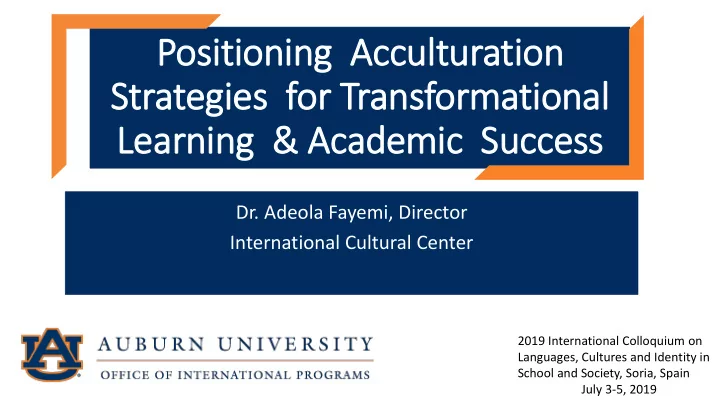

Positioning Acculturation Strategies for Transformational Learning & & Academic Success Dr. Adeola Fayemi, Director International Cultural Center 2019 International Colloquium on Languages, Cultures and Identity in School and Society, Soria, Spain July 3-5, 2019
Native Born hostility; pressure to assimilate culturally/racially; stereotyping; isolation; Acculturation Challenges intergenerational; mental health ; post traumatic stress Access to healthcare; Absenteeism; poverty; Structural Challenges undocumented status; familial separation; Outside School resource-deprived schools; homelessness; immigration apathy High stakes testing environment; harmful educational policies; isolated low resource Structural Challenges schools; overcrowded classrooms; Within School overrepresentation in special education; underrepresentation in gifted/talented programs Challenges Facing Limited preparation for facing newcomer & Teacher Education immigrant; focus only on formal curriculum; Programs subtraction vs. additive teaching approaches; lack of training on implicit bias; resistant teachers
ACCULTURATION Acculturation . Acculturation can be defined as the ' process of learning and incorporating the values, beliefs, language, customs and mannerisms of the new country immigrants and their families are living in, including behaviors that affect health such as dietary habits, activity levels and substance use
Family, Work, School, socio- political climate Family : Parents and Children - Acculturation Discrepancies Institutional Level: The School and workplace Societal Level: - Attitudes, policies and prejudices Advancing Acculturation Theory and Research: the acculturation process in its ecological context Coleen Ward & Nicolas Geeraert, Current Opinion in Psychology Volume 8, April 2016, Pages 98-104
Florida’s Population Boom The state has added 1.2 million people over the past five years, more than any other state except California and Texas, and at a higher rate of increase than those two larger states.
Current FL Immigration: Is the Sky Falling?
Public Education for Im Immigrant Students Plyler v. . Doe In June 1982, the Supreme Court issued Plyler v. Doe , a landmark decision holding that states cannot constitutionally deny students a free public education on account of their immigration status.
Florida’s 67 Counties and School Districts
Pathways to Opportunities: Promising practices for Immigrant Children, Youth & Their Families 1-Orientation to the new land; 2-Educational efforts oriented toward parents; 3-Educational efforts oriented towards children and youth; 4-After-school activities for children & youth; 5- Improving the host societies’ perceptions of immigrants. White paper by Carola Suarez-Orozco, Marcelo Suarez- Orozco & Robert Teranishi, Institute for Iimmigration, Globalization and Education, 2016
Information on Educational Pathways Pre- Migration Citizenship Information Information, Welcome Centers Orientation Adult Vocational Mentoring to the New Training Land Employment Support for Information Parenting in the New Access to Affordable Housing and Land Health Services
Parent Leadership Councils Discover Your way: New Language Parent Workshops; Development Academies Educational Efforts Oriented Parent Needs 2-Educational efforts Literacy Toward Parents Assessment & oriented toward parents Development Focus Groups Community Connections & Family Literacy Liaisons Program - Library Accessing Employment in the Market Place
College Pathway Knowledge & Post Secondary Practices Language Development; Bi New Comer Programs lingual counselors, Paraprofessionals Educational Efforts Summer Advisory Groups, Academic 2-Educational efforts Directed to Children Enrichment Supports, Mentoring & oriented toward parents & Youth Health Services Heritage Language Development Professional Development – School Staff & Faculty Services for SIFEs
Community Educational Field Trips Youth Academic Post Secondary Supports Tutors & Role Modeling After-School Extra- Curricular Youth Mentoring Activities for Activities Youth Risk- Behavior College Readiness Prevention Programs Cultural Identity
Community Story Telling Programs Municipal Policy Education Local Review to Service providers Accommodate Immigrants Improving Host Combating Negative Society’s Sponsored trips to Stereotypes – Immigrants Country Perception of Adults/Children of Origin Immigrants Improve Front Office Facilitating contact Services Between Native Residents & Citizen Mentoring Newcomers Programs
Closing the Gaps • Holistic strategies- evidence based, data driven • Utilize background and resources of the immigrant families into programing to increase a sense of community • Do not conflate non-linguistic strategies for ELLS and newly immigrant students • Incorporate US history, immigrant stories and accomplishments into the curriculum • More individualistic approached, caring, empathy, etc….avoid over reliance on technology
Closing the Gaps • Focused Teacher Professional development not just large conferences – feedback/teaching of takeaways to colleagues • Focused Teacher Professional development not just large conferences – feedback/teaching of takeaways to colleagues • Encourage teachers to think outside the box of formal curriculum to culturally relevant classroom methods • Constant monitoring of use of classroom strategies and certification of teachers and paraprofessionals • Create reward & recognition system based on holistic criteria
Closing the Gaps • Encourage more buddy programs connecting immigrant student and U.S. students • Train all teachers, staff and paraprofessionals, districtwide
Family, Work, School, socio- political climate Family : Parents and Children - Acculturation Discrepancies Institutional Level: The School and workplace Societal Level: - Attitudes, policies and prejudices Advancing Acculturation Theory and Research: the acculturation process in its ecological context Coleen Ward & Nicolas Geeraert, Current Opinion in Psychology Volume 8, April 2016, Pages 98-104
Recommend
More recommend